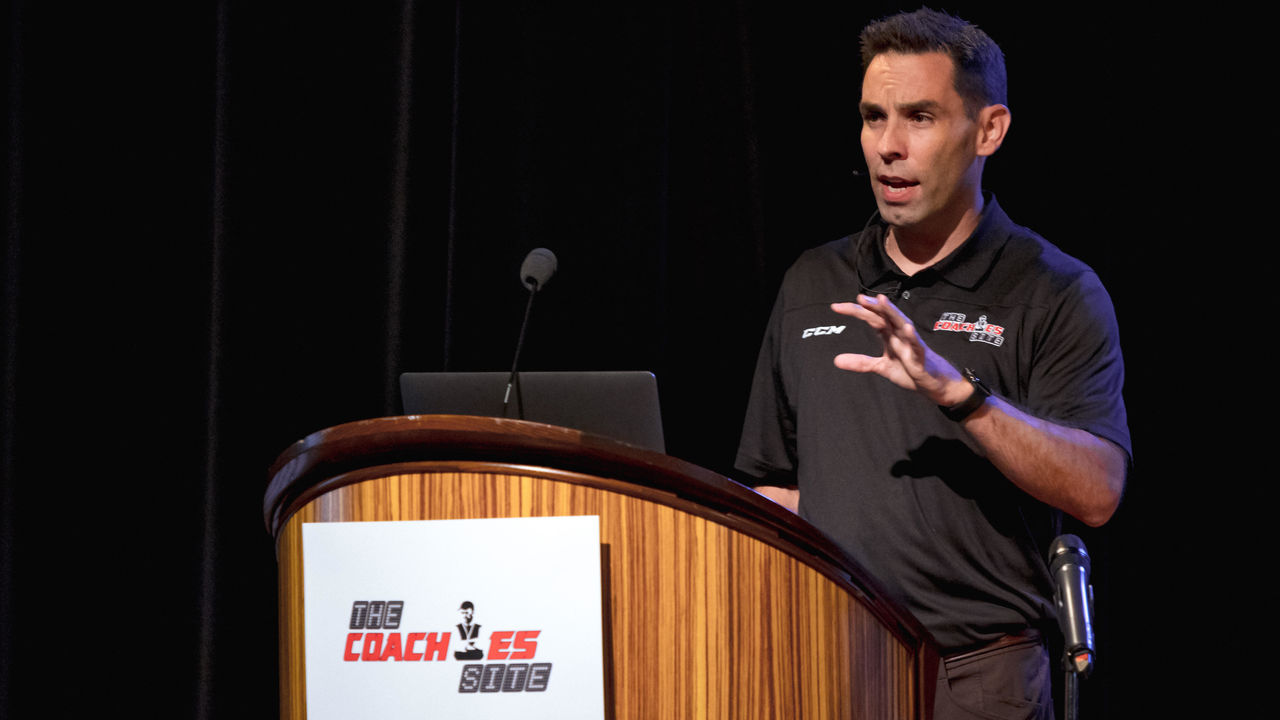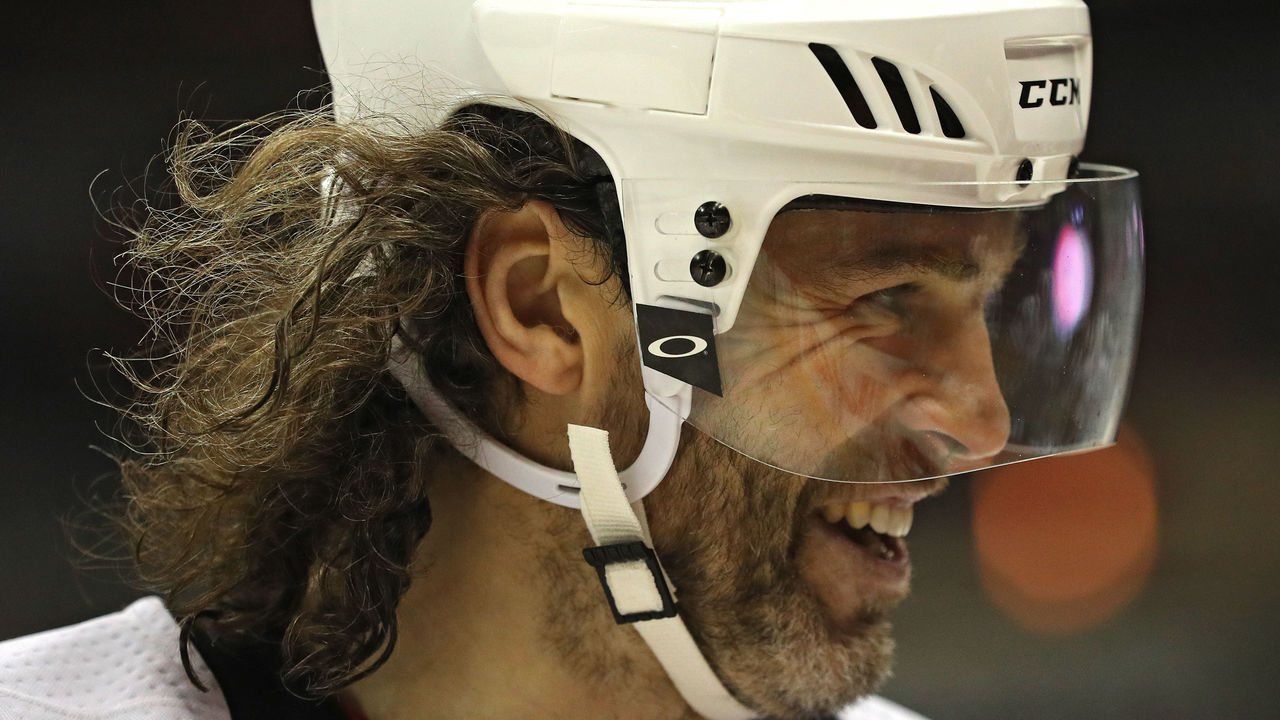4 takeaways from the annual coaches conference: It's all about zone entries
TORONTO - Hundreds of coaches from all levels of hockey gathered at Humber College this past weekend for the TeamSnap Hockey Coaches Conference.
The annual two-day event featured a series of presentations from a diverse list of speakers. This year’s headliners included two former NHL head coaches, Senators associate coach Marc Crawford and Oilers assistant coach Glen Gulutzan.
Related - Q&A: Marc Crawford on millennials, Auston Matthews, and the Senators
Here are four takeaways from the conference:
In vogue: Keep the puck, find the middle man
Industry meet-ups can be useful for identifying tactical trends across the NHL.
From an Xs and Os perspective, the study of different offensive zone entries is definitely in vogue. And coaches are almost exclusively promoting creativity over mundane approaches like the dump-and-chase.
Jets assistant coach Todd Woodcroft broke down the importance of puck management and forcing the opposition to make mistakes when hemmed in their own end.
"Hockey, really, it’s not about scoring," Woodcroft said, quoting his boss, Jets head coach Paul Maurice. "Hockey is about creating offensive zone time, offensive zone pressure, and sustaining it."

Upon entry, the puck carrier has a number of viable options. A popular pick: feeding the puck to a teammate streaking through the middle of the ice. Woodcroft noted that some teams - like the Maple Leafs, Oilers, Sharks, Blackhawks, and Jets - are known as "middle drive" clubs, meaning they nearly always attempt to feed that streaker.
Naturally, Woodcroft used Jets winger Patrik Laine to demonstrate this type of entry. Laine, who has 80 goals in 155 NHL games, is exceptional at hustling to the net while a teammate brings the puck into the offensive zone. The Finnish sniper will find the middle lane and prepare for a scoring chance.
Below are a couple of examples of Laine doing his thing. Notice in these two GIFs how Laine keeps his feet moving through transition, presents himself as a pass target, and reacts instantly when the puck enters his orbit:
Patrik Laine gets goal #16. Knocked the pass down right out of the air. pic.twitter.com/o21LJdxdt0
— Brady Trettenero (@BradyTrett) December 4, 2016
What a pass from Patrik Laine. Really sold the shot. pic.twitter.com/SErlBjBA8w
— Brady Trettenero (@BradyTrett) March 5, 2017
Laine's signature move may be his wicked shot, but his willingness to make a B-line for the goalmouth is probably underrated. He loves that middle lane.
Woodcroft, who broke into the NHL in 2000 as a video coach for the Minnesota Wild, says the Jets encourage all of their skaters "to take the ice in front of them at all times." If a defenseman happens to be the puck carrier at the offensive blue line, so be it.
"It used to be that the D were told to hold the blue line - your job is to defend," he said of a league-wide trend toward operating in five-man units. "Now we’re seeing how much the D are involved. Guys like Erik Karlsson - not only are they involved in the rush, they’re leading the rush."
Hartsburg an open book to teens
Mental health awareness is another area of the sport - and society, for that matter - gaining traction.
Chris Hartsburg is doing his part to minimize the suck-it-up attitude prevalent inside dressing rooms. The 38-year-old head coach of the OHL’s Erie Otters has no problem telling players about his battle with depression.
"For me, it’s nothing to be afraid of," Hartsburg said in an interview. "There’s not as much stigma towards it anymore and it’s slowly starting to get to the point where everyone is being very open about it. But, you still have the issues where people are either ashamed, afraid, or they don’t know what’s going on, and I think it’s important to have open dialogue about it."
Hartsburg says he was diagnosed with eight concussions during a playing career that plateaued with five pro seasons. The Colorado College alumnus suffered all eight in his mid-20s, but he didn't start suffering from depression until his 30s.
"You’re in a dark place. You don’t feel like getting out of bed," said the son of former NHL head coach Craig Hartsburg. "You just sit there and don’t do anything and, fortunately, my wife was a big turning point for me and helping me feel better about myself. She pushed me to get help, see a therapist, and find the medication that works for me. Those are the types of things that I found worked.
"I can’t control my depression, unfortunately. It’s going to be there and, potentially, it could get worse. I can combat it. I’m active, I did as much as I can to get outside and enjoy the outdoor life. But it wasn’t fun and it’s something that I don’t allow to control me anymore."
Where is the love for goalies?
Steve Briere of the Maple Leafs made a valid point during his presentation outlining a development plan for goalies - North Americans don’t give netminders enough TLC.
Through work trips overseas, the renowned goalie coach has noticed some countries - namely goalie factories Sweden and Finland - place a greater emphasis on building up the position and the people playing it from an early age.
"The No. 1 thing they do is they praise goaltenders," Briere said of Finland, home to NHL starters Pekka Rinne, Tuukka Rask, and Antti Raanta.
Briere feels that parents and coaches in Canada and the U.S. tend to make excuses for why young players shouldn’t be goalies. He constantly hears about kids being too skilled or too tall or too fast to strap on the pads.
Also grinding his gears: "Goalies only try to work on the mental side of the game when they start struggling. The problem with (that strategy is that) it’s too late. You talk to a goalie when he’s struggling and he doesn’t hear half of the things you’re saying to him. OK? So that’s something we need to work on every day."
Briere, as you can imagine, is the ultimate goalie spokesperson.
"Everything I have in my life is from being a goalie. I’m a midget. I’m a short, fat, bald guy from Winnipeg," he said. "I’ve got a masters degree, a beautiful wife, beautiful kids, I’ve been around the world - all from being a goalie. It was the greatest gift I’ve ever been given."
Jagr apparently a man of his word

Finally, an anecdote about the man, the myth, the legend - Jaromir Jagr.
Presenter Dave Barr, who coached the future Hall of Famer in both New Jersey (2013-14, 2014-15) and Florida (2015-16), relayed an amusing story from an undisclosed assistant coach.
"There’s a knock at the door. He’s the closest coach to the door so he goes to the door and it’s Jagr," started Barr, now an assistant coach for the San Jose Sharks.
"Jagr says, 'Tell the (head) coach that I feel great tonight. I feel great, tell the coach I feel great. I get points, I get goals for sure tonight. Tell him!'
"So, he goes, 'OK, I’ll tell him, I’ll tell him.' (Jagr) goes away."
"Coaches meeting is a half hour later and the head coach, at the end, says 'Anybody got anything?' Assistant coach says, 'Yeah,' he goes, 'Jagr came by and said he feels great tonight, can you give him a few extra shifts?' Head coach goes, 'OK, I’ll squeeze him in, I’ll give him a few extra shifts.'
"That game: two and two. Jagr: two goals, two assists. And they win.
"Next game, knock on the door - this is a true story ... same assistant coach goes to the door, opens it, 'I feel good again, I’m telling you I feel great. Tell the coach to play me!'
"He gets three and one.
"So, this goes on for a little bit ...
"Another knock on the door - this is a couple of weeks later now. Assistant coach (thinks it’s) Jagr again. Opens the door, it’s Jagr.
"Jagr says, 'Tell the coach I just got back from Vegas, I feel like s---! Don’t play me too much tonight!'"
HEADLINES
- Redick: Luka 'vomiting all afternoon' ahead of Game 3 loss to Wolves
- Skenes strikes out 9, wins duel with Yamamoto in Pirates' victory over Dodgers
- Oilers score 10 seconds after Kings' failed challenge for Game 3 winner
- Wolves top Lakers in Game 3 to take series lead
- Running analysis of Round 1 of the Stanley Cup Playoffs